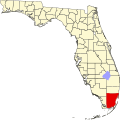Little Gables, Florida | |
|---|---|
| Coordinates: 25°45′37″N80°16′14″W / 25.760351°N 80.2705203°W | |
| Country | United States |
| State | Florida |
| County | Miami-Dade |
| Government | |
| • Governing body | Miami-Dade County |
| • Mayor | Daniella Levine Cava |
| Time zone | UTC-5 (Eastern (EST)) |
| • Summer (DST) | UTC-4 (EDT) |
| ZIP code | 33134 |
| Area codes | 305, 786 |
Little Gables is an unincorporated community in Miami-Dade County, Florida. The name "Little Gables" comes from the community being located between the cities of Coral Gables and Miami.


